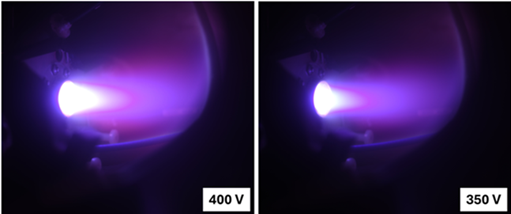Dual-Mode Propulsion Systems to Meet Next-Generation Mission Requirements
Apollo 11 Postdoctoral Fellowships at Purdue - Proposal
Timothée Pourpoint, Professor, and Alexey Shashurin, Associate Professor
Overview and Goals
In collaboration with the Electric Propulsion and Plasma Laboratory at Purdue University, led by Dr. Alexey Shashurin, the Pourpoint research group has, over the last several years, performed fundamental research and development of various propulsion technologies related to dual-mode (or multi-mode) propulsion. A dual-mode propulsion system is defined as a system that, to at least some degree, has synergistic functionality between a chemical and electrical system.

Figure 1. Dual-mode compatible pulsed plasma thruster developed in partnership with EPPL and Pourpoint group.
For complicated mission profiles, both high-thrust chemical and high-performance electric propulsion systems are often ideal. However, when chemical and electric propulsion systems are integrated as entirely independent systems, mass and volume fractions owned by the propulsion system can be severely constraining. To reduce this constraint, it is beneficial for propulsion systems to share common propellants or even common thrust hardware. Combining systems reduces dry mass dramatically and has the capacity to significantly reduce system complexity while retaining the mission agility and adaptability enabled by access to both systems.
The Pourpoint group is seeking a qualified postdoctoral candidate to assist in fundamental research and system development of next-generation dual-mode systems throughout the following stages of development:
- Identifying candidate systems, propellants and techniques that enable streamlined functionality between a proposed chemical and electrical propulsion system, including shared tankage, feed systems, controls, etc.
- Identifying trade spaces for spacecraft mission profiles where candidate systems may outperform existing technology (i.e. where agile and adaptable propulsion systems may offer an advantage to mission outcomes, spacecraft lifetime, or trajectory optimization).
- Developing models for these systems, including combustion kinetics, heat transfer, plasma dynamics, electrostatic and electromagnetic field interactions, thrust and specific impulse.
- Fabricating and testing conceptual systems and testing the feasibility of proposed systems against developed models.
- Proposing recommendations based on observed capabilities and limitations for architectures that may continue to 6.3-level research as defined by Department of Defense Research, Development, Test, and Evaluation (RDT&E) taxonomy.
Research Plan and Expected Outcomes
Throughout the course of the postdoctoral appointment, the candidate will be expected to transition a proposed technology through fundamental and applied stages of research. As part of this work, the candidate will be expected to produce peer-reviewed journal articles in addition to presenting technical work at conferences where appropriate. The student will also be expected to mentor and assist graduate students within the Pourpoint group. Final deliverables at the end of the appointment can include:
-
Validated models or simulations (CFD, EM, plasma, structural, etc.)
-
Prototypes or sub-scale test articles demonstrating technology feasibility
-
Experimental data packages with uncertainty analysis and metadata documentation
-
Concept-of-operations (CONOPS) outlines or design envelopes (for 6.2 work nearing 6.3 readiness)
-
White papers or grant proposals for the continuation of foundational work into higher levels of engineering development
To ensure long-term sustainability and impact, the postdoc will support the definition of 6.1 and 6.2 research endeavors Purdue could use to socialize multi-year government funded projects with program managers within the Department of Defense. Specifically, the postdoc will work with Drs. Pourpoint and Shashurin to target opportunities such as the Multidisciplinary University Research Initiative (MURI) program and long-term collaborations with agencies such as DARPA or the NRO. These programs will enable Drs. Pourpoint and Shashurin, and the postdoc, to expand their research scope, support collaborative teams, and accelerate the transition of multimode propulsion technologies to operational space missions. Purdue’s recent investment in a $1.5M Thermal Vacuum Chamber, championed by Drs. Pourpoint and Howell and expected to be fully operational at the Zucrow Labs by July 2026, will further strengthen these research proposals.
Affiliated Faculty
Professor Timothée Pourpoint and Associate Professor Alexey Shashurin
School of Aeronautics and Astronautics, Purdue University
